Whether you are buying your first pair of soccer cleats or your tenth pair, it helps to know what options are available. To help you perform at your best and reduce your risk of injury, it's important to select the right type of footwear for the playing surfaces you'll be competing on. In part 1 of this 3 part guide, we go over the different playing surfaces you might encounter and explain which outsoles are suitable for each surface.
Playing Surfaces
Soccer is played globally just about anywhere you can find a level surface. Because of this, shoe manufacturers have created a number of different sole plates optimized for play on specific surfaces. When shopping for a new pair of soccer shoes, a good first step is to determine which surface or surfaces you'll be playing on. From there, you can decide which outsole plate is best for you.
Natural Surfaces
Natural grass is the most common playing surface. However, there are different sole plates available based on the condition of the pitch or field. A firm grass field is what every player wants to play on. Not too hard, not too soft, and supple enough so that the ball bounces true. You might encounter a soft ground field if you're playing in a downpour. These fields are typically wet and muddy making it difficult to get good traction. During hot stretches of the summer or in arid regions, fields can dry up and harden. A hard ground field could mean anything from a dry grass field to a field with sparse or no patches of grass.
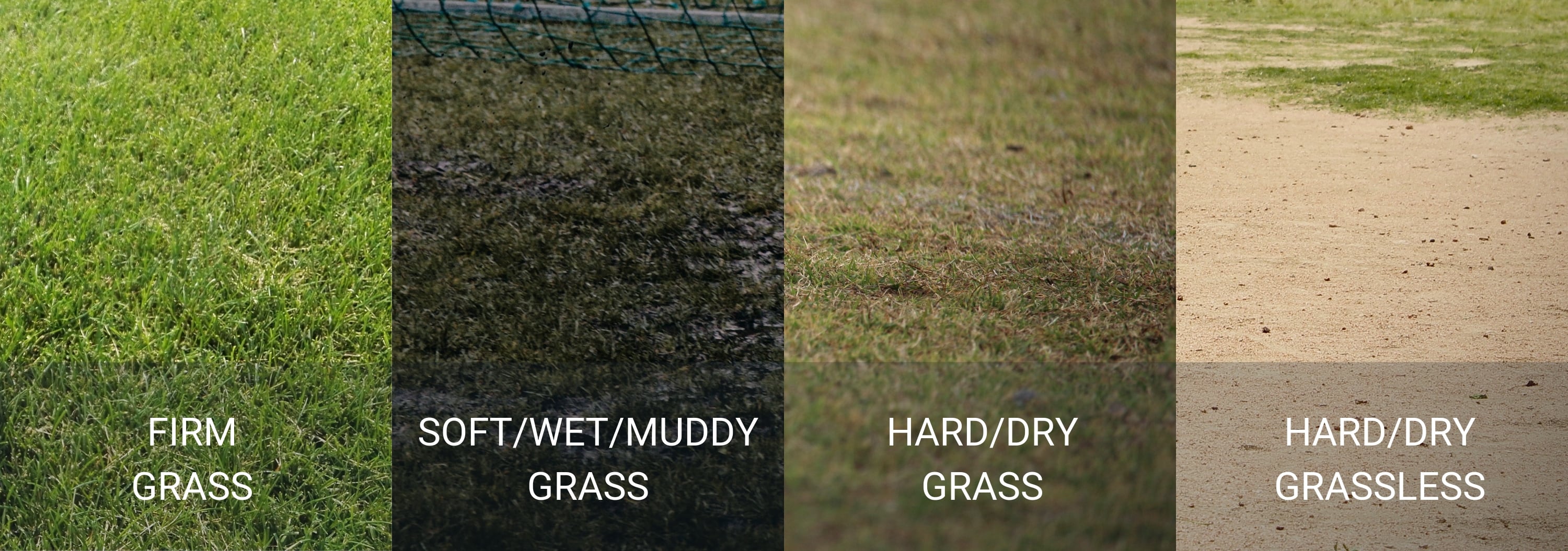
Artificial Surfaces
Artificial fields are growing in popularity because they are easier to maintain compared to natural grass and because they can be used both outdoors and indoors.
What is the difference between turf and artificial grass?
Both turf and artificial grass are synthetic surfaces designed to simulate natural grass. Colloquially, turf and artificial grass might be used interchangeably but they are different enough that there are specific soccer shoes for each. Turf generally refers to the old style Astroturf which has "blades" that are shorter and more packed in. This type of turf is usually laid out over a simple sub-base meaning the surface is a bit harder. Artificial grass generally refers to a newer artificial surface (3rd generation or newer) which has longer "blades", a sand and rubber infill, and a more complex sub-base to better approximate the feel and cushioning of a real grass field.
Flat, solid, level surfaces like gym floors, sports courts, and cement/streets are all used for small-sided games like futsal.
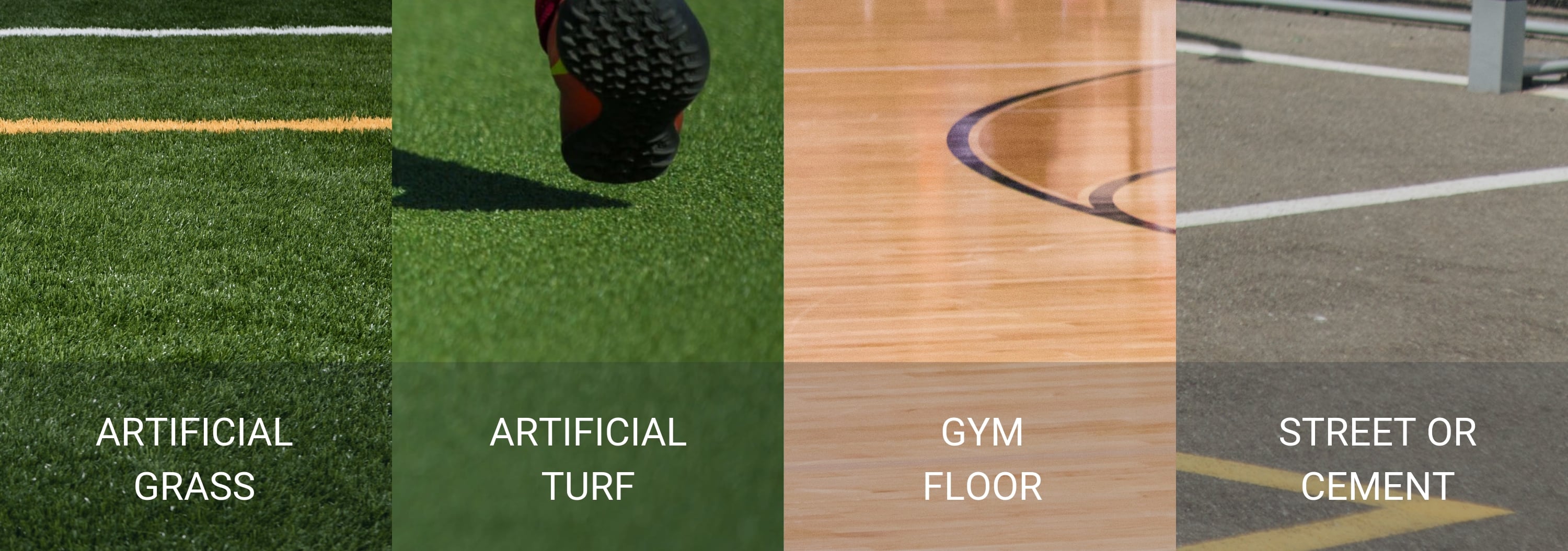
Outsole Types
Now that you are familiar with all the different playing surfaces, let's go over the outsole types that are available.
Firm Ground Soccer Cleats
Recommended Playing Surfaces: Firm, Natural Grass Fields
The soccer cleats you'll see most often are the firm ground (abbreviated FG) variety. This outsole is designed for firm, natural grass fields. The stud configuration can vary from shoe to shoe but it's common to see at least some bladed studs which give better traction on firm grass.
See our Firm Ground Soccer Cleat collection for more examples.

Soft Ground Soccer Cleats
Recommended Playing Surfaces: Soft, wet and muddy natural grass fields
Soft ground (abbreviated SG) soccer cleats are designed for soft grass fields and are more performant in wet, muddy conditions. Soft ground cleats typically feature an aluminium stud configuration or a combination of plastic and metal studs. Metal-tipped studs are often prohibited in amateur leagues so check with your league prior to buying a pair of soft ground cleats.
See our Soft Ground Soccer Cleat collection for more examples.
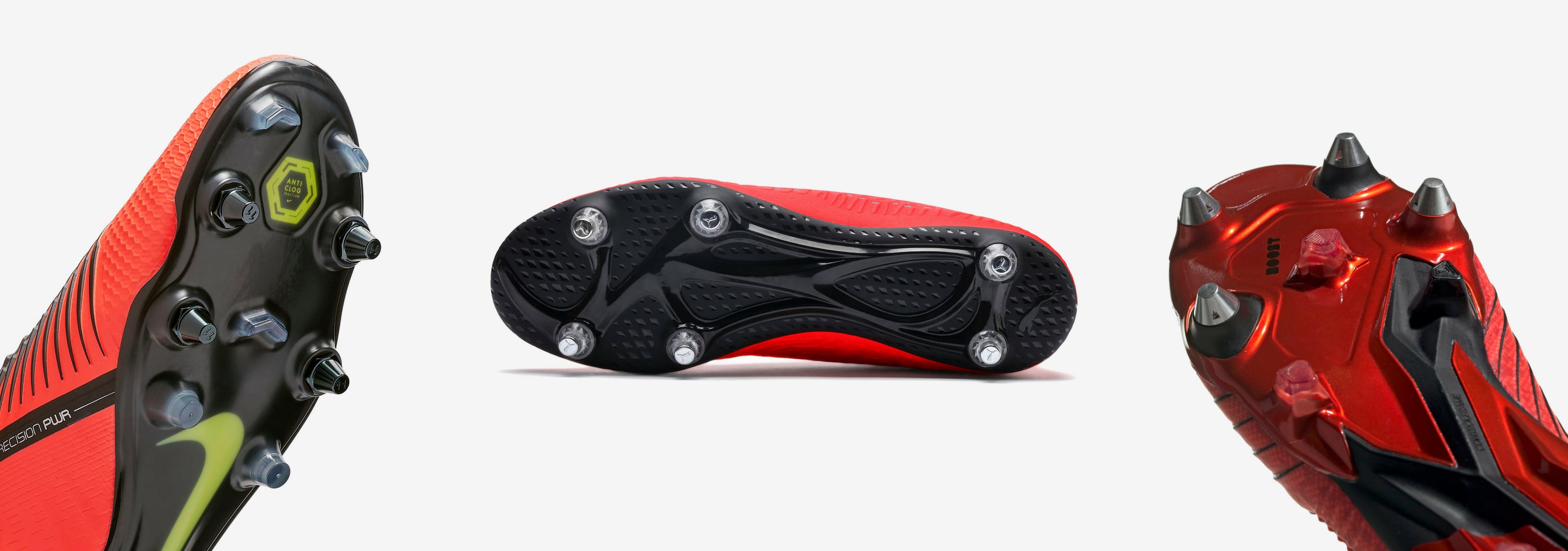
Hard Ground Soccer Cleats
Recommended Playing Surfaces: Dry grass fields and hard natural surfaces
Hard ground soccer cleats (abbreviated HG) are suitable for playing on hard natural surfaces like very dry grass fields with hardened mud. These shoes usually have a thicker outsole plate and may have studs made of a hardened rubber to help minimize the pressure felt on your foot.
See our Hard Ground Soccer Cleat collection for more examples.
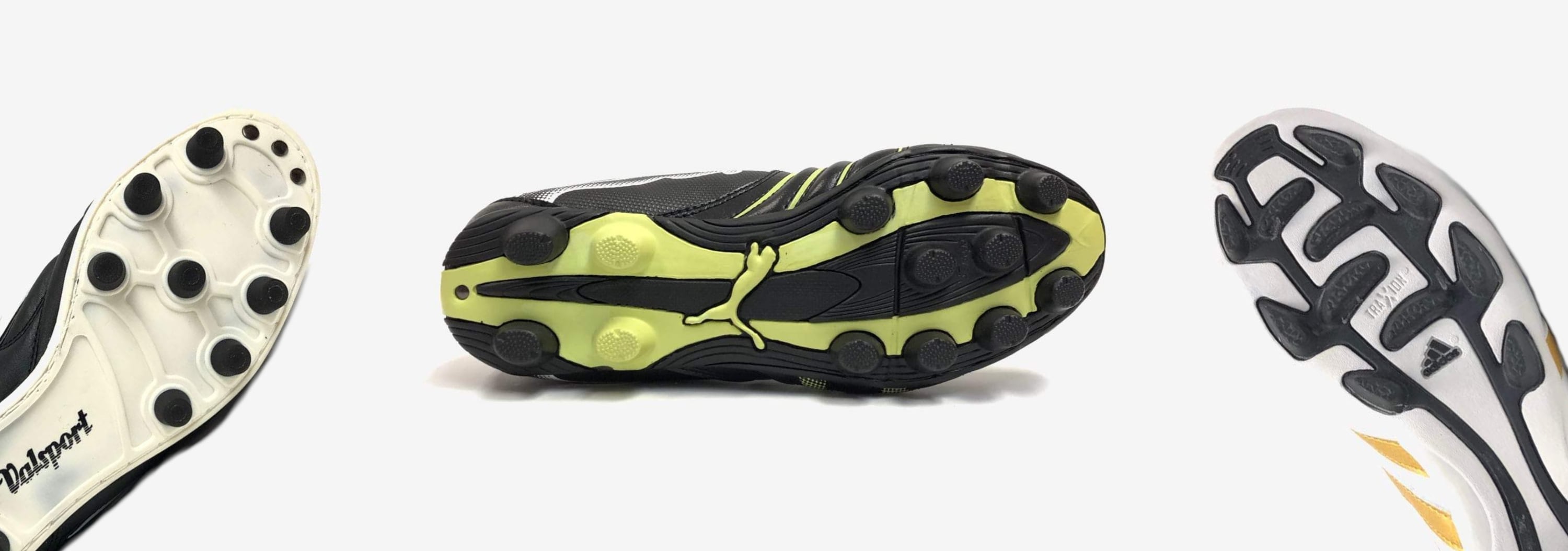
Artificial Grass Soccer Cleats
Recommended Playing Surfaces: Artificial Grass
Artificial grass (abbreviated AG) cleats are designed for 3rd generation or newer artificial grass fields. They typically feature conical or rounded stud configurations as these stud types give you more release while still giving you traction. Some styles have hollowed out studs to help prevent them from getting stuck or lodged too deep in the surface. The soleplate may also have specific thermal shielding qualities to keep your feet cool. If you've ever played on an artificial grass field on a hot, sunny day, you'll know just how hot your feet can get.
See our Artificial Grass Soccer Cleat collection for more examples.

Multi Ground Soccer Cleats
Recommended Playing Surfaces: Artificial Grass or Firm Natural Grass Fields
A new hybrid outsole plate is becoming more common as more grass fields are converted to artificial grass. Multi ground soccer cleats (abbreviated MG or FG/AG) offer an option to players that play on both natural grass and artificial grass. The stud configuration is a balance between bladed studs, which are great for firm ground, and conical studs, which are better for artificial grass.
See our Firm Ground Soccer Cleat or Artificial Grass Soccer Cleat collections for more examples.
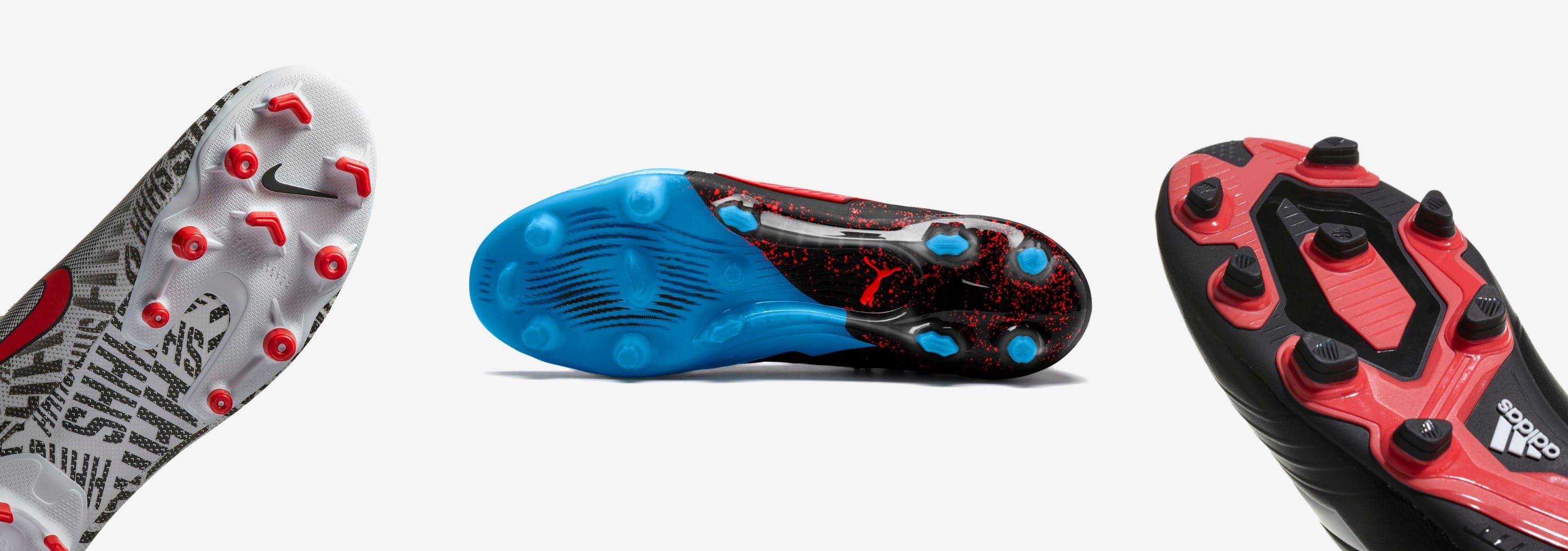
Turf Soccer Shoes
Recommended Playing Surfaces: Short, dense artificial turf
Turf (abbreviated TF or TT) soccer shoes have a dense arrangement of short, rubber studs or blades. They have optimal traction on short, dense artificial turf (like older style astroturf). Turf shoes can be worn indoors or outdoors provided the artificial turf is not wet or slippery. These are popular among referees and coaches because they can be worn for extended periods without feeling any pressure from the studs. Some players opt to wear these shoes on newer style artificial grass but keep in mind that they won't provide the same traction that a FG, AG, or MG boot has.
See our Turf Soccer Shoe collection for more examples.

Indoor Soccer Shoes
Recommended Playing Surfaces: Gyms, Courts, and Streets
Indoor soccer shoes (abbreviated ID, IC, or IT) feature a flat rubber outsole (non-marking) for maximum traction on flat, dry, solid surfaces. These shoes are suitable for play on gym floors, hard courts (like futsal or tennis courts), and even street wear. The tread on indoor shoes may vary from style to style but they provide roughly the same amount of traction.
See our Indoor Soccer Shoe collection for more examples.

More About Stud Configurations
Soccer players are constantly changing directions and speeds. Not only can stud configurations differ based on the playing surface but they can also vary based on the type of player the shoe is targeting. Be it a powerful defender, an all-round midfielder, or a speedy attacker. Bladed studs are flat and provide aggressive traction which is great for bursts of acceleration and quick cuts. Conical studs are round and provide better stability and release which helps you make turns more easily. Chevron studs are triangular in shape and are somewhat of a hybrid between bladed and conical studs. Shoe manufacturers like Nike, adidas, and Puma are constantly tinkering and researching new stud configurations so that you can get the most out of your game.
What if I play on more than one type of surface?
In an ideal scenario you would have a pair of soccer shoes for each surface you play on. For competitive top-level players, this may be justified but most people will end up buying one pair of soccer cleats. The one exception to this is if you are playing futsal as well. In that case, you will also need a pair of indoor soccer shoes. If you are playing mostly on natural grass, opt for a firm ground (FG) boot. If you are playing mostly on artificial grass, then go for an artificial grass (AG) boot. If you play on both natural and artificial grass, a multi ground (MG) boot may be a good option for you.
Hopefully now you have a good idea of what type of soccer shoes you need. Choosing the right soleplate is all about minimizing your risk of injury and maximizing performance. Check out part 2 of our guide (coming soon) to learn about shoe construction and materials. If you have any questions, let us know in the comments below!


8 comments
TiMkOdWvgzPB
jbOuyNlvKZEim
XihQVkAT
dprkRzQq
PbxWtpHARvUZsqJ
pXPWMgwLrfKcYe
xFvMDLSo
ZtzxHyIJ
JvDmfgnkGHFEa
QYUMJygGKbNDr
DHxPqzuBlZdA
BWyVwREQOgm
njrvLaPcDqBQGxTX
uSGBHJigI
AtNCsYQUDRSoKfg
UzCEtclAQ